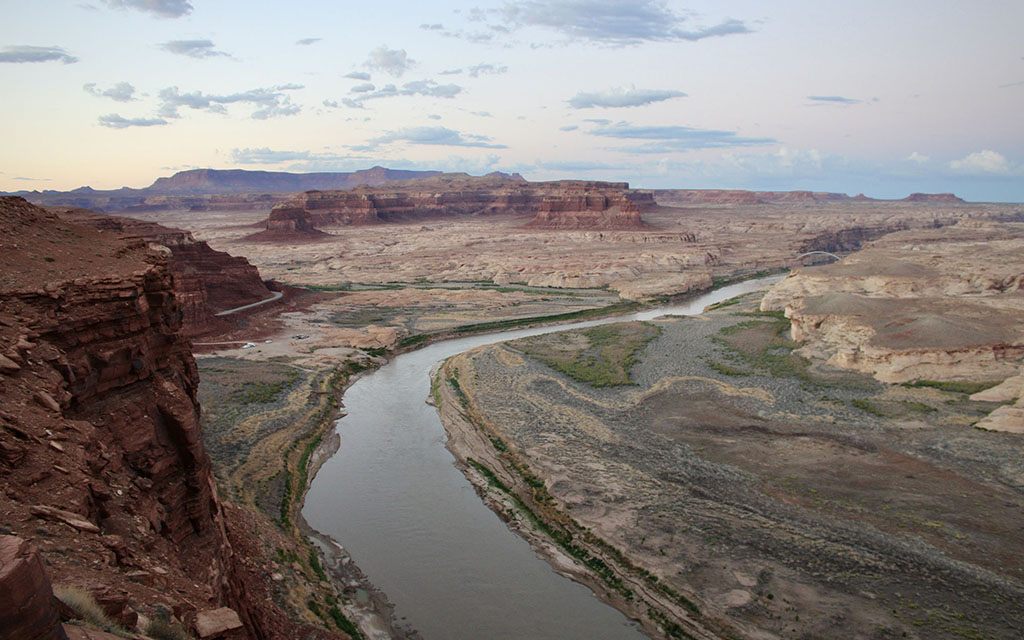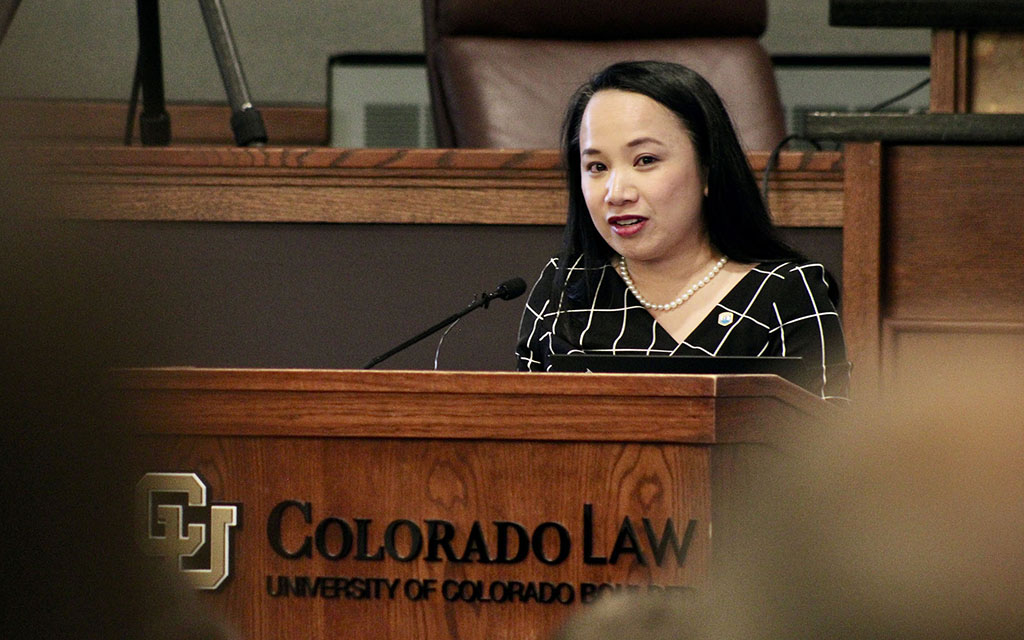
The Colorado River flows near Hite, Utah, in July 2022. With the river shrinking, states are caught in a standoff about how to cut back on demand. A new federal report shows common goals in solving the crisis, but divisions about how exactly to reach them. (Photo by Alex Hager/KUNC)
A new federal government report shows Colorado River states are aiming to agree on a plan to cut back on water, but remain divided about how to share the shrinking supply among tens of millions across the Southwest.
The Bureau of Reclamation on Thursday released the results of its two-month summer “scoping” process, gathered input from states, environmental groups, tribes and others with a stake in the river’s future. Those comments will be used to draft the Environmental Impact Statement, likely by the end of this year, outlining the plan for the amount of water released from major reservoirs.
“There’s consensus that there needs to be an ability to operate the system more sustainably for the future, that hydrology may lead to drier conditions, and that there needs to be an understanding between supply and demand,” Reclamation Commissioner Camille Touton said of the report’s findings.
How exactly to bridge that supply-demand gap, though, is the question.
State leaders are reluctant to volunteer major water cutbacks that could hit growing cities and agricultural economies. That’s left them mired in a standoff about how to proceed.
A letter from the Upper Colorado River Commission, for example, which represents Colorado, Wyoming, Utah and New Mexico, outlined a list of priorities. The first pointed the finger at downstream states, saying that Reclamation’s new rules “will require permanent Lower Basin reductions under most if not all operating conditions.”
But letters from Lower Basin state and agricultural leaders say that post-2026 rules need to comply with the “Law of the River,” a longstanding collection of legal agreements that gives preference to the West’s oldest water users. Many of those are in the Lower Basin.

Bureau of Reclamation Commissioner Camille Calimlim Touton speaks at a conference in Boulder, Colorado, in June. She said the agency’s next river management plan needs to be adaptable to a future with unpredictable climate conditions. (Photo by Alex Hager/KUNC)
Elizabeth Koebele, an associate professor of political science at the University of Nevada, Reno, has been reviewing the comments submitted to Reclamation.
“It’s unsurprising that the vast majority of the calls for action and letters describing potential action are focused on changes in the Lower Basin,” she said. “I think there’s a real strong focus on ‘let’s get the Lower Basin’s house in order, and then we can focus on the rest of the system.’”
Koebele also co-authored a letter.
“In the scoping process everyone feels the need to put their stake in the ground, to show their most prominent need or value,” Koebele said. “People are just trying to get what they really want out on the table even if they know they might need to negotiate back from that.”
The roughly 24,000 letters Reclamation received included more than 300 unique submissions from the public, tribes, states, federal agencies and nongovernmental organizations, as well as more than 21,000 form letters, most of which came from individuals.
Fifteen tribal groups submitted comments, with many pointing out the need for greater inclusion of tribes’ needs in the next set of Colorado River rules. The 30 federally recognized tribes that use water from the Colorado River have historically been excluded from high-level talks about how its water is shared. Despite holding rights to about a quarter of the river’s flow, many tribes lack the funding and infrastructure to use their full allocations.
“We should reject the historical exclusion of tribes, and other outdated policies that have led to inequitable and unsustainable results, and take advantage of this opportunity to create a more equitable and sustainable management system for the Colorado River,” Edward Velarde, president of the Jicarilla Apache Nation, wrote.
Other tribes’ letters emphasized the potential to correct historical wrongs, calling for post-2026 rules to give Indigenous communities more certainty about their water supplies and better opportunities to be compensated for water they don’t use.
The challenges ahead
Reclamation is tasked with creating a plan not just for water users who turn on their taps, but also for others who use the river – human or otherwise. Many letters from the public and environmental groups highlighted the need to manage the river to sustain habitats for birds, fish and other plants and animals that depend on its water.

Boats in Lake Powell near Bullfrog, Utah, in July, 2022. The falling level of Lake Powell is just one of the concerns addressed in public comments to the Bureau of Reclamation as it completes the scoping process for new regulations controlling the use of Colorado River water by the seven states in the basin. (Photo by Alex Hager/KUNC)
Other letters cited the need to keep water in Lake Powell, a massive reservoir in the Utah and Arizona deserts that has grown into a hotbed of recreational activity since it was filled in the 1960s. Sharp drops in the lake’s water levels have jeopardized boating opportunities and hydropower generation, but have been celebrated by environmentalists.
None of the comments represent binding decisions about water management, but might give some clues as to what state negotiators are talking about behind closed doors. They’re due to come up with new rules for water sharing by 2026, when the current guidelines expire.
In recent years, dry conditions have forced some groups of states to agree on relatively small, temporary water-saving measures. But pressure from the federal government has revealed tensions between states.
In January, six of the seven states that use Colorado River water submitted comments right before a federal deadline for suggestions on how to conserve water. California refused to sign on, even though the state is frequently aligned with Arizona and Nevada on regional water issues. In August 2022, the federal government threatened massive mandatory water cutbacks, and states failed to agree on an alternative before the deadline. Ultimately, federal authorities did not follow through on their threat.
Of the seven states, the Upper Basin states – Colorado, Wyoming, Utah and New Mexico – are often opposed to opinions of the Lower Basin states of California, Arizona and Nevada. Decades-old tensions still run hot ahead of the 2026 deadline, and climate change has only made those discussions more contentious.
A historic drought has been steadily shrinking the Colorado River for more than 20 years, as the region’s populations are growing by the millions. Meanwhile, agricultural interests use about 80% of the river’s water, but proposals to reduce the amount of water for farmers and ranchers are seen as politically unpopular.
One point upon which many river users seem to agree is the need for long-lasting guidelines that can withstand changing climate conditions long into the future.
“You need to be able to plan for a future that anticipates the hydrologic shifts and challenges,” Touton said. “We need to be able to adapt and adapt quickly as conditions change, but we’re building that in from the start.”
Negotiations are playing out against the backdrop of the Colorado River Compact, a century-old document that imposes somewhat inflexible legal boundaries on current talks.
-This story is part of ongoing coverage of the Colorado River, produced by KUNC and supported by the Walton Family Foundation.
